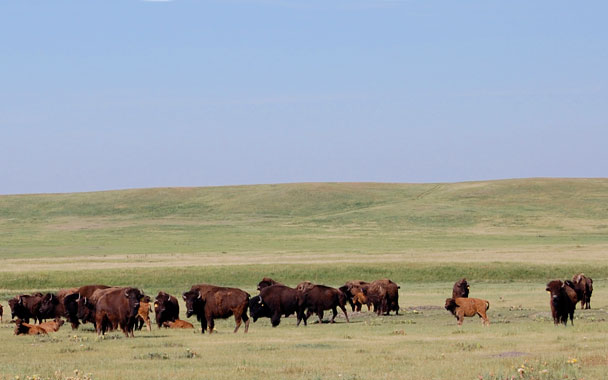I won! Last month Jim Lutter bet me a steak dinner that central South Dakota would have frost by the September full moon. It’s been warm and cozy all week. “Unseasonably warm,” Scott Christenson reported from Brown County. “And we’ve gotten five inches of rain in the last two weeks.”
South Dakota farmers are genetically programmed to complain about the weather, so leave it to a local rancher to offer a cautionary note, putting a chill on the moment. The last time it was this warm and wet this late in the summer, the winter was vicious. That was ’96–’97. It snowed and packed, and snowed and packed, and melted and froze, and snowed again until a table of ice covered the tops of fence posts. South Dakota looked like the Arctic, layers of aqua blue and wind-blown white to the horizon. Five hundred thousand cattle died from the cold that winter in South Dakota alone. That was also the year that buffalo escaped from the Cheyenne River Sioux Reservation and tried to walk across the ice to Kansas. The governor had to call out National Guard helicopters to round them up. Only one buffalo died, though: It got spooked by a truck while it was wandering across a bridge on the Missouri River, and jumped. That winter got a lot of cattlemen thinking about buffalo. Jim Lutter was one of them.
With all the clamor about the prices of commodity corn, soybeans, and wheat, it’s easy to lose track of the fact that before these plains were plowed to a dust bowl in the early 20th century, this was the greatest cattle country in the world. Before that, it was a kingdom of grass and buffalo. Dale Hargens, Charlie Johnson, and Jim Lutter all manage some version of the hybrid “pasture farm” that John Wesley Powell advocated after the Civil War. Among the four operations I’ve been writing about over the past weeks, only the Christenson brothers have abandoned their last connections to cattle, choosing to get out of them all together and plow 1,500 acres of pasture to corn and soybeans.
A small number of farmers and ranchers, like Jim Lutter, think that it could be profitable to adapt small family operations like his to the ancient interactions of grass and animals. Lutter is hardly a sentimental romantic. He considers himself a businessman first and a cowboy second. But his business plan is upside down from those of Dale Hargens and the Christenson brothers. Rather than invest in expensive equipment and expensive inputs of herbicides, fertilizers, pesticides, and diesel fuel, Lutter is trying to make money by reducing costs. He’s trying to create a closed loop. He grows a crop of perennial intermediate wheatgrass, which he strips for seed each August (this year, he made 62 cents a pound from a local seed dealer), and then bales to feed his animals in the winter. He grows corn and contracts with neighbors to buy their corn to feed animals in his feedlot. (Neighbors like the idea of selling their corn to Lutter, just two miles down the road, rather than trucking the corn to a grain elevator or ethanol plants 50 or 100 miles away.) He also feeds the animals “distillers dry grain,” a high-protein byproduct of corn after the sugar has been extracted, which he buys from an ethanol plant outside of Mitchell, South Dakota.
For 15 years, Lutter raised beef cows. “I was running three hundred and fifty head of beef, but I wasn’t making any money. I liked beef. I liked pulling calves, and working with them. But I was making only about thirty to one hundred and fifty dollars a head,” he explained. “When I tried to feed cattle, it was the biggest bloodbath I ever took.” So, after the winter of ’96–’97, he decided to build a small niche feedlot specifically for buffalo. It has a 2,000-animal capacity. Going into this winter, Lutter has 200 animals on feed. He buys or contracts to feed yearling buffalo that come in weighing about 600 pounds. He adds just under 2 pounds a day, sending the animals to processors after 260 days at around 1,050 pounds. If everything goes right (which it rarely does), Lutter takes home $350 an animal.




 Pinterest
Pinterest


